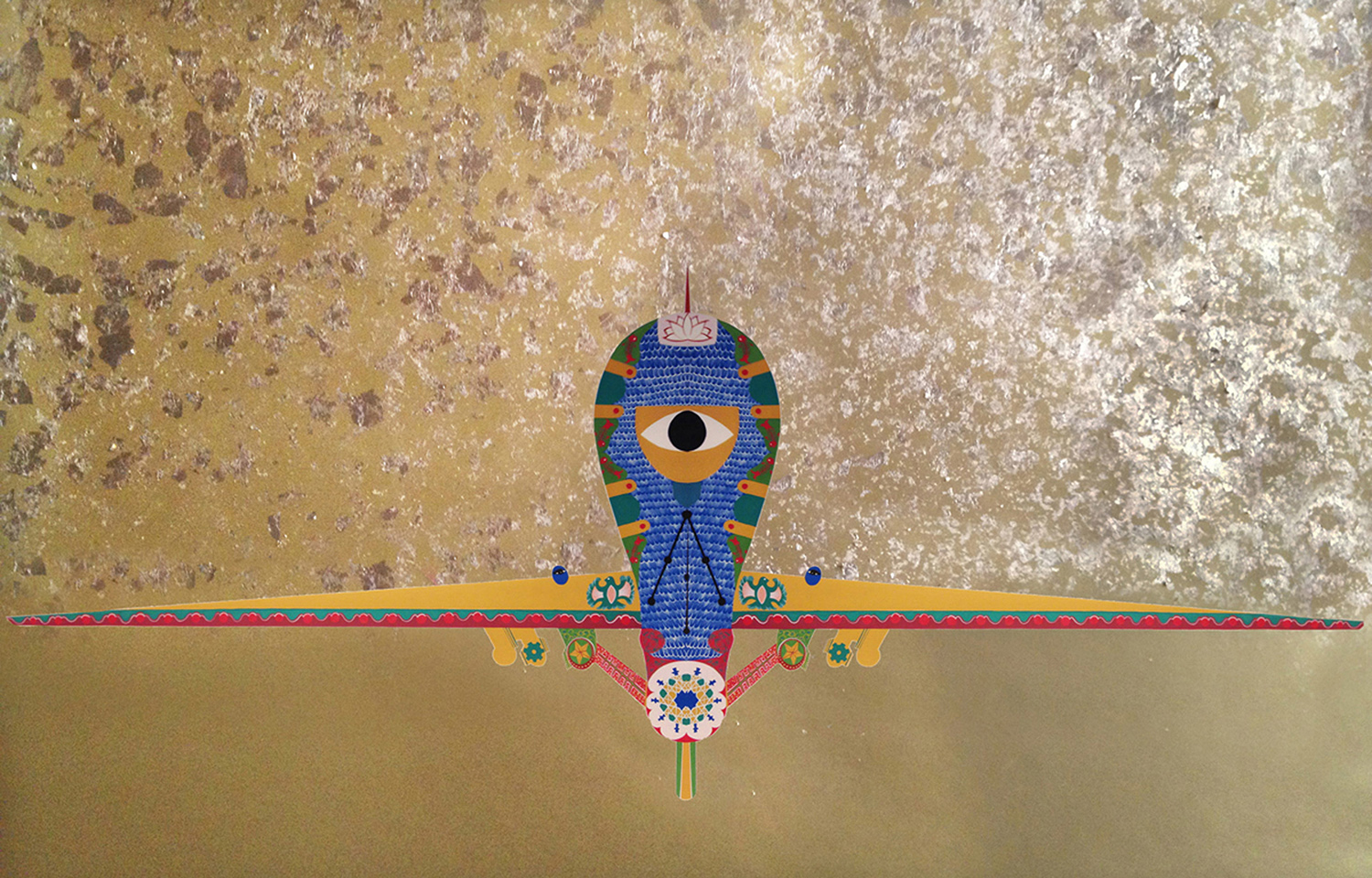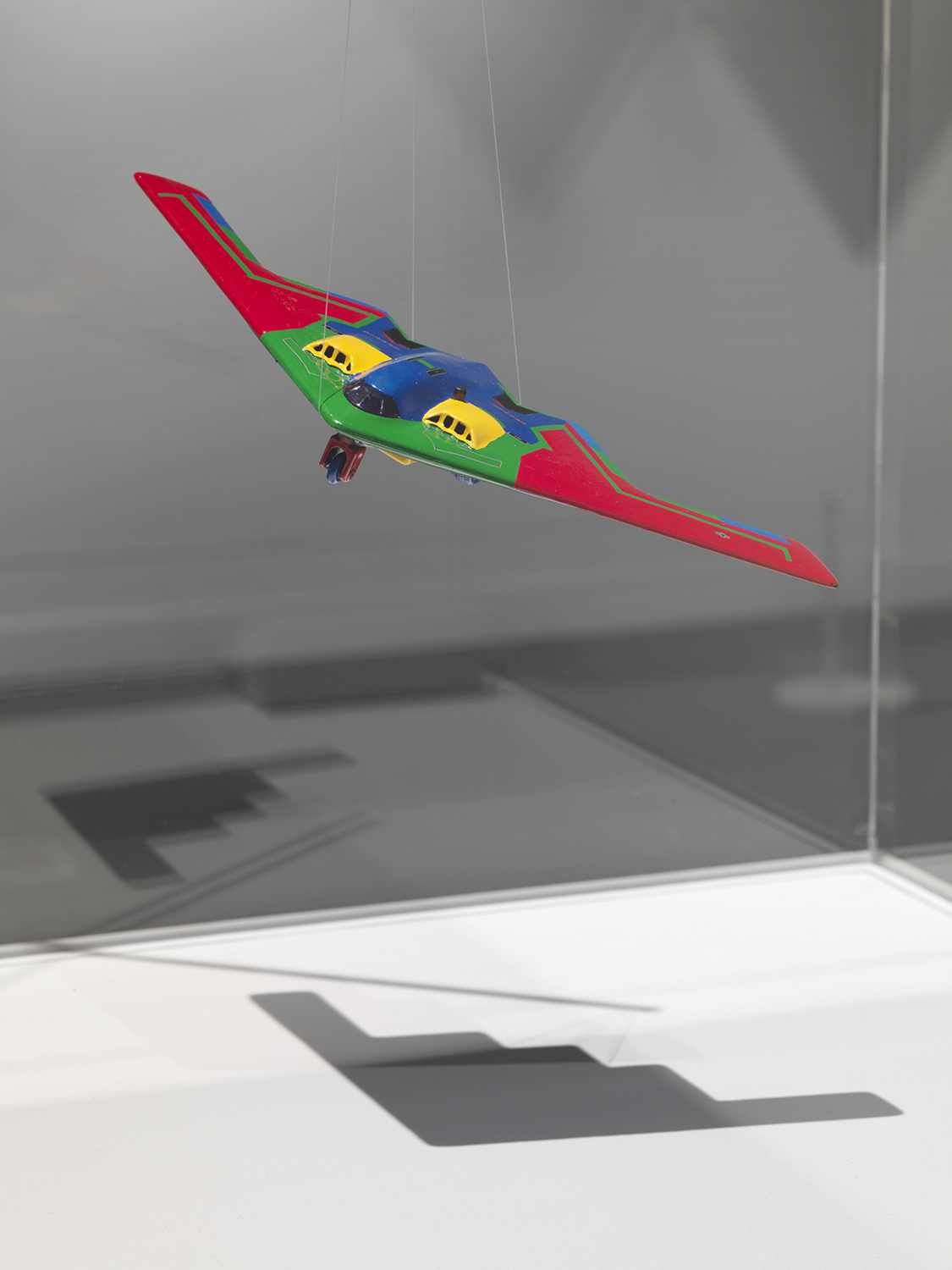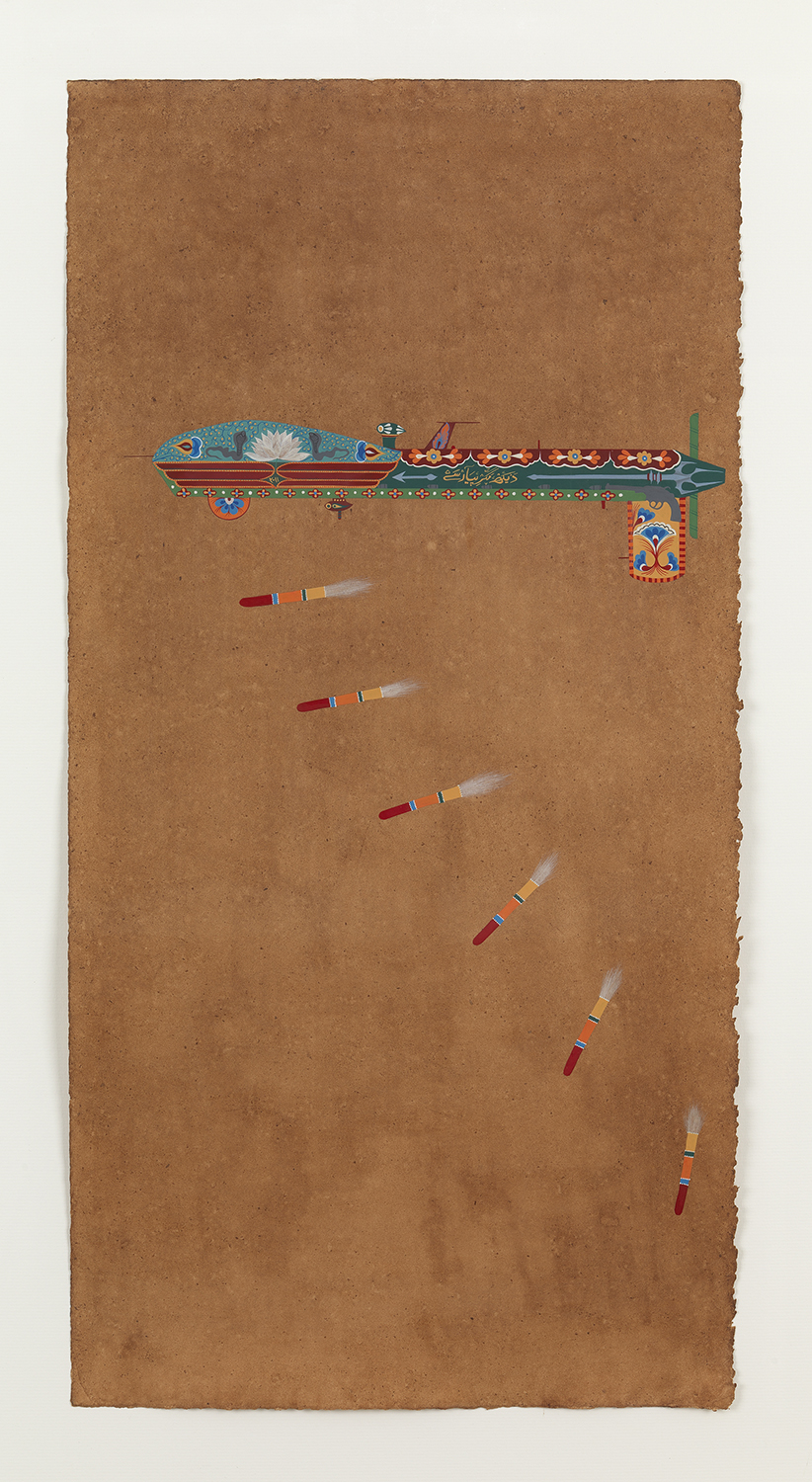Shows
Mahwish Chishty at the Imperial War Museum


Looking at Mahwish Chishty’s elaborate, mixed-media paintings of military drones, I am led to make comparisons to photomontage artist Peter Kennard’s Haywain with Cruise Missiles (1980), another work conceived in protest of the use of cutting-edge technology to create new terror weapons, and the subsequent placement or deployment of such weapons. Chishty and Kennard both produce a violent collision between the stark visual form of modern weapons technology and the horrific implication of its use, thus stirring unease within viewers. In Kennard’s piece, which is now part of the Tate’s collection, the United States Air Force’s Tomahawk Cruise Missiles—complete with nuclear warheads for maximal destruction—are inserted into the pastoral idyll of John Constable’s English countryside, making a target out of the artistic heart of the national schools’ painting tradition. In the same vein, Chishty uses the techniques of Mughal miniature painting, another artistic school that also carries patriotic weight, and combines it with motifs from Pakistani folk art, to fill in the silhouettes of the US drone air vehicles.

The lightness of Chishty’s touch and the charm of the works belie the seriousness of her project. Extreme absurdity in the juxtaposition of elements gently introduces the viewer to the horrific realities of drone warfare in Pakistan. The gouache paintings are brightly decorated with flowers, birds and ornate patterns resembling mandalas. An eye features prominently in Reaper (2015); the vehicle gazes out from a gold leaf skyscape—playing with misconceived notion that Pakistani tribal areas where American military drones frequently drop bombs are in a depopulated desert. The incongruous merging of machinery and South Asian mythology draws on the habit of truck drivers in Pakistan to personalize their vehicles with similar motifs; dozens of these vehicles have been destroyed in drone strikes. The brightly decorated trucks are intended to be aspirational, a contrast to the harsh reality in which they operate. In Reaper, the disembodied evil eye—a curse believed to be spawned by a malicious gaze—illustrates the profuse use of military drones by the Central Intelligence Agency in North Pakistan; high-speed data links allow operators to carry out attacks without ever leaving the US. The impact of the drone campaign on tribal life in Pakistan is a direct experience for the artist, whose extended family remains in the country. Though she has been based in the US for the last decade, Chishty made these works in reaction to changes in family life due to the drone campaign, after she learned that her relatives are fearful of stepping outside. By fusing the mechanical forms of drones with the cultural patterns of Mughal miniatures, Chishty presents the ambiguity of her position as a transnational artist creating art from a subjective position informed by her life in the US, a country that is the aggressor, while promoting a local identity based on a formal presentation of the courtly Pakistan miniature tradition. Chishty’s use of miniature painting techniques is an important conceptual link to contemporary artists from Vietnam and Cambodia still dealing with the legacy of US bombings, as well as the status of returnee artists as described by historian Pamela N. Corey in an essay titled “Beyond Yet Toward Representation: Diasporic Artists and Craft as Conceptualism in Contemporary Southeast Asia” in The Journal of Modern Craft. She says, “Of acute importance here are the ways in which the artists deploy craft as a vehicle to create conceptually driven formal iterations, drawing both on semiotic play, such as language, and material subversions, for example [. . .] recombination [. . .] to produce dialectical imagery.”
On plinths in the middle of the gallery are four small sculptures of drones from 2015–16 created from commercially available toys and model kits, painted in a similar style to the pieces on the walls, though with less detail and in bolder colors. That these sculptures are made from children’s playthings emphasizes the war-gaming element to the CIA’s bombing campaign—it is being played out with no regard for the consequences. The conversion of the US military hardware into quasi-folk art objects, displayed here in cases that echo the exhibits of war paraphernalia in the rest of the Imperial War Museum, also suggests how quickly those in the US and Western Europe have become desensitized to an ongoing aerial bombing campaign taking place in South Asia.
Chishty’s layering of her signature style on the drones is a dignified attempt to redress the imbalance of a one-sided military assault. The brightly colored MQ-9 Predator (2011), adorned with Chishty's ornately painted cobras, looks like a float decorated for a festival; even the rockets it releases resemble cheery fireworks. And yet, the constant presence of drones in Pakistan has put an end to much community activity. In By the Moonlight (2013), an angled mount of the birch plywood surface, on which the street scene and drone are depicted, projects the work into the gallery space, strengthening the vehicle’s presence. On the machine’s face, Chishty drew two doves that give the drone eyes, harking back to the nose art of World War II bomber planes that became a Pop Art staple. Chishty’s works provide a perspective that makes the affected people invisible, and instead personifies the unmanned aerial vehicles. By layering the drones with her locally derived designs, the artist asserts her cultural identity, and provides a sense of locality for the region in what has otherwise become another faceless campaign of uncalculated death and destruction.
Mahwish Chishty’s exhibition is currently on at the Imperial War Museum, London, until March 19, 2017.








